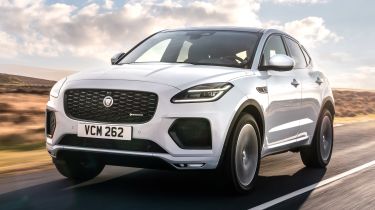Jaguar E-Pace review - Interior, design and technology
The E-Pace stands out with its sporty exterior design, but the interior feels a little plain

With one successful SUV already in the bag, you’d forgive Jaguar if it decided to spin the E-Pace off simply as a scaled down version of the popular F-Pace. However, that’s not quite what has happened from a design standpoint.
Look closer and you’ll see that the design language employed by the E-Pace is completely different. While the F-Pace takes after the firm’s established line-up of saloons, this smaller SUV takes its inspiration from the F-Type sports car, the shape of the grille and the headlights are a dead giveaway.
Elsewhere, the E-Pace’s bending roofline and kinked window line are much more aggressive than on the F-Pace, feeding into a chunky little hatch lid spoiler. The car’s overhangs are particularly short too, noticeably at the rear. Finally, there’s a more angular theme to the E-Pace’s tailgate and taillights than on any other Jaguar. All cars feature twin exhausts.
Styling differences between the regular E-Pace and the sportier E-Pace R-Dynamic are subtle, although only the latter is now available to order from the Jaguar price list. The R-Dynamic gets a revised front apron with larger, singular air intakes either side of the grille, front fog lamps plus a slightly different rear diffuser. Some of the black plastic exterior trim elements are transformed too, and become body painted. R-Dynamic cars ride on different alloy wheels too, and come with grilles finished in gloss black. Touches inside include bright metal pedals, metal tread plates, and sports seats.
The interior feels much more conventional in design. The dashboard itself is long and flat, rather than upright, while the positioning of the vents, infotainment display and climate control settings is straightforward and at hand. It can feel a little conservative though, in a class where style and technology are becoming big selling factors.
Used - available now

2018 Nissan
Qashqai
52,849 milesManualDiesel1.5L
Cash £10,900
2022 Peugeot
5008
46,225 milesManualDiesel1.5L
Cash £18,506
2023 Ford
Puma
67,042 milesManualPetrol1.0L
Cash £12,506
2023 Mercedes
EQC
21,307 milesAutomaticElectric
Cash £26,000The metals and leathers used in the cabin feel good, and while the plastics are soft to the touch, it feels like Jaguar has leant a little too much on that material. The entirety of the dashboard surrounding the steering wheel and instruments is covered with plastic, as is the area around the gear selector’s chrome housing. As such it can look a bit drab, depending on spec, but there are plenty of interior colour schemes to choose from.
Sat-nav, stereo and infotainment
All pre-facelift Jaguar E-Pace models are equipped with a 10-inch touchscreen infotainment system called Touch Pro which is far from perfect. Running software known as InControl it’s a little slow to respond compared to the likes of BMW’s iDrive system or a Mercedes COMAND unit, but at least Apple CarPlay and Android Auto were available on S trim models and above.
One of the best bits of facelift news was that JLR has ditched the Touch Pro set-up and all versions now boast a much improved 11.4-inch infotainment screen set-up running the firm’s latest Pivo Pro operating system. It has great graphics and the menus and layout are all greatly improved.
The 12.3-inch fully digitalised instrument panel with configurable interfaces that was standard fit on the fully stocked HSE grade has now been standardised across the line-up too.











